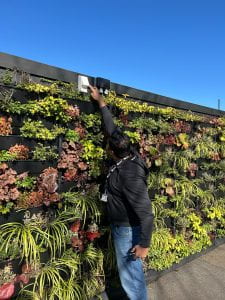With World Earth Day soon on the horizon, we caught up with Prem Kumar Perumal, PhD researcher, to hear about BDFI’s efforts in becoming net zero.

If you have visited BDFI recently, you may have noticed the wall of green plants that greet you as you approach the entrance.
These biowalls are one element of BDFI’s Net Zero facilities, part of the Sustainable Campus Testbed project which is implementing and researching carbon reduction technologies.
The plants in the green walls have been carefully selected to suit the north and south facing elevations, with a focus on species that help with air purification. The walls feature a matrix of plants that grow well together to create year-round coverage and seasonal interest.

Prem Kumar Perumal has been leading on the monitoring of air quality around the building and explains how it works.
“We have sensors installed in different locations in and around the building. There are six sensors above the green wall and an additional two sensors inside the building on the first and ground floor. They measure critical environmental parameters including temperature, sound levels, CO2 levels, carbon monoxide and small particles in the air.”
“We have been monitoring data from the sensors since June 2023 and are already seeing some interesting findings. Last November when Canford Park held a fireworks fiesta, we measured an increase in particulate matter levels for eight hours at BDFI, 4.7 miles away from the source.
“This shows the impact of fire and fireworks on the surrounding area, not only in the distance travelled by particulates but also in how long they are present for.”
Particulate Matter (PM) refers to a complex mixture of solid particles and liquid droplets in the air.
Prem explains: “These particles vary in size, composition, and origin. PM can originate from both natural sources, such as wildfires, volcanic eruptions, and dust storms, as well as anthropogenic sources, including industrial processes, vehicle emissions, construction activities, and agricultural operations.

“Governments and environmental agencies worldwide monitor and regulate PM levels to protect public health and the environment. Strategies to reduce PM pollution include improving emission standards for vehicles and industrial facilities, implementing cleaner technologies, controlling dust emissions from construction sites, and promoting alternative transportation modes.
At BDFI, Prem monitors the different particulates to monitor trends and patterns.
He said: “I am monitoring the spikes in the dashboard on a regular basis and gather information to understand the source. This could be an outdoor event or building works, for example.”
The biowalls and sensors are just one aspect of the Net Zero work going on at BDFI. You can read about the other carbon reduction technologies we are working on, including our smart energy system, on our website.

